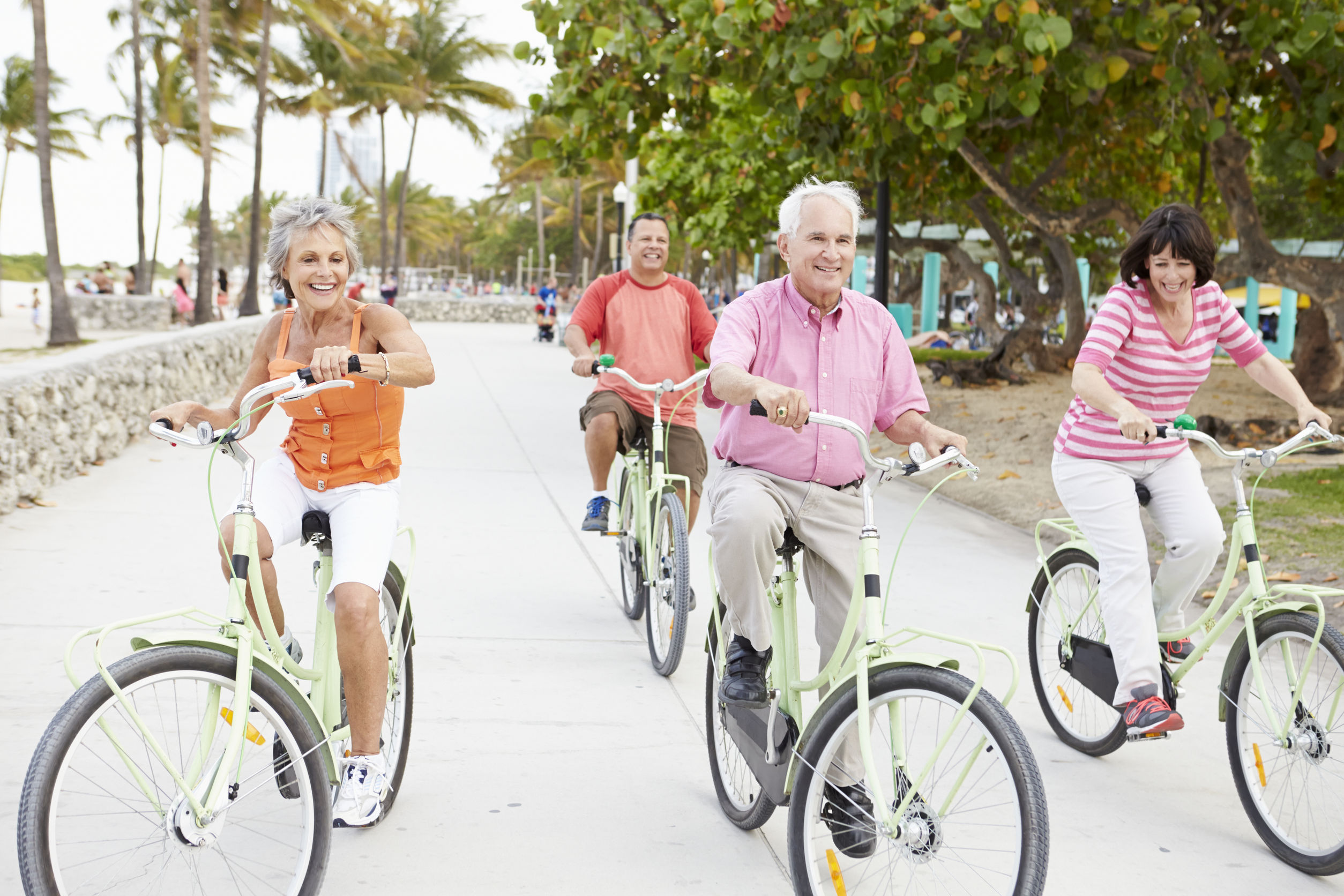The interest in active older adult communities in the Province of Ontario is growing. This is especially true for the cities of Ottowa and Toronto. One of the reasons driving interest in 55+ developments is the current growth rate of the active older adult population in Ontario. Another reason is the diversity in housing choices that cater to residents who are ready for a lifestyle change. Active older adults want to spend their well-earned time and money on self-enrichment now that they’re no longer responsible for raising children or being in the labor force full-time. This regional description outlines the forces driving interest in the growth of active older adult communities, the diversity in the choice of communities, and the types of amenities that are important to this emerging population.
The Growing 55+ Population in Ontario
The Province of Ontario is leading Canada in the growth of the 55+ age group. This fast-growing age group is forecasted to double in the next twenty-five years. Ontario’s government is proactive in addressing the preferences of an active older adult population. They are working to accommodate this demographic by encouraging new developments that cater to active older adults.
As of 2020, the 55+ population is estimated to be over 2.6 million. That number is projected to grow to 4.6 million as the youngest of the Baby Boomer generation ages into the 65+ demographic. The Baby Boomer generation is living longer, having fewer children, retiring later, and preferring communities of like-minded neighbors.
Developing Active Older Adult Communities
Ontario takes its lead on what active older adults want regarding services and amenities from the World Health Organization’s (WHO) Age-Friendly Communities (AFC) white paper. The WHO’s investigation found eight important domains that determine how a senior’s personal well-being, and their contribution to the community, impact their quality of life and decision-making process on what type of community they will choose to live in for this stage of their life. These eight domains are important to consider when building developments that cater to the needs of this growing population sector.
The Age-Friendly Communities (AFC) Guidelines
Well-planned Age-Friendly Communities (AFC) consider the physical environments, transportation options, social and civic participation, inclusion, communication of community information, health services, and diverse housing choices in their planning.
Physical Environment
Developers who build their communities to service the 55+ active older adult residents will spend extra attention on the outdoor spaces and community buildings. Making minor adjustments to create safe and accessible public spaces helps the individual residents feel comfortable participating in community events. Many developments pay extra attention to entrances into buildings and gathering spaces by substituting stairs and steps with No-Step entries with ramps. Well-planned communities pay close attention to non-slip flooring, widened doorways, automatic doors and/or levered door handles, handrails, and covered shelters with seating in gardens and along nature trails.
Transportation Options
Many active older adults are looking for ways to get around that supplement or substitute private car use. Having a community with convenient nature trails that accommodate pedestrians, cyclists, and golf carts is very appealing to the 55+ active residents. Being able to run errands, go shopping, attend medical appointments, and enjoy local cafes and restaurants without driving is very appealing to active older adults.
Being close to safe and reliable public transportation is especially important in urban centers where driving is complicated, and parking is expensive. Developers who align the goals with the AFC’s domain of transportation, build communities that include good signage, well-timed traffic signals, wide sidewalks, and convenient public transportation.
Social and Civic Participation
Social participation requires communities to design their public space to accommodate a variety of resident-driven interests. Well-designed communities have spaces that can be used for a variety of activities.
For example, a theater can be used to screen movies, broadcast sporting events, and host live performances and interesting lectures. A dedicated arts and crafts studio encourages active older adults to use the space to express their creative prowess without having to worry about having enough table room or storage space for supplies.
One of the latest additions to 55+ communities is a dedicated garage or shed that is used as a maker space. A maker space is a place where active older adults can build, tinker, and wrench without having the burden of buying and storing tools and supplies. Having access to 3D printers, mechanic tools, carpentry supplies, and the like improves social participation and encourages residents to share their knowledge and skills with one another.
Civic participation is encouraged in 55+ communities through the creation of personal and group volunteer opportunities, voting, and holding office. Many active older adult communities have community gardens to grow your favorite produce for personal consumption and to share with your neighbors. Some communities will have volunteer opportunities such as the Homeowners Association positions, community sports team captains, and social group organizers. Having a say in the governance of your community is an important part of active older adult communities.
Inclusion
Respect for your neighbors and the experience they bring to the community goes a long way in promoting inclusion in choosing where you want to live. Having a common lifestyle and interests makes promoting inclusivity much easier. Using social media, community bulletin boards, and nearby age-friendly businesses increases the community’s ability to include its residents in opportunities to take advantage of all that active older adult developments have to offer.
Communication
Developers of active older adult neighborhoods are taking a greater interest in how to best to communicate to current and potential residents all the advantages of living near like-minded people. As the population continues to age, with better health and fewer family obligations, it’s important to advertise your amenities and services in both traditional and modern forms of communication.
Traditional forms of communication include direct mail flyers, newspapers, television and radio, and sponsorship of local teams and clubs. Technology has increased the reach for advertising to potential residents through social media, electronic newsletters, virtual information Q&As, and on-demand video tours. Advances such as mobile phones and real-time video conferencing facilitate remote conversations that appeal to the 55+ consumers of today.
Health Services
Active older adults take their health seriously. They enjoy a variety of physical and mental exercises and visit medical professionals regularly. Communities that have an on-site gym make exercise convenient in any season. Some communities employ Activity Directors who organize group exercise classes that pair staying fit with community fellowship. Developing 55+ communities near medical service providers is important in choosing where the active older adult chooses to reside.
Housing Options
Whether you’re looking for a single-level bungalow on the lake or a luxury inner-city apartment, the choices for 55+ active adults have few limits. The adage “location, location, location” is as important as the features, style, and ownership choices that active older adults benefit from when choosing a lifestyle.
Location
In the Province of Ontario, the active older adult community choices are vast and varied. Active older adult communities can be free-standing homes, clustered townhomes, manufactured homes, luxury apartments, life-lease units, and graduated care facilities. Developers are responding to the increased demands for housing that suits the market’s lifestyle needs and budgets.
Waterfront
If living on the waterfront is what appeals to you, there are single-level bungalows for sale in planned, lake-front communities. These communities feature lake-view residences and private docks. There’s a community clubhouse and a maintenance staff to take care of the grounds and roads. Leaving yard work and snow removal up to someone else makes for plenty of time to enjoy fishing, sailing, and exploring the shoreline.
Condos and Apartments
Building condominiums and apartments in the suburbs give the “right-sizing” 55+ crowd the option of staying near friends, family, work, shopping, and places of worship. Public transportation is right at your doorstep. The building’s interiors and exteriors are the responsibility of the management company. The city views from the high-rise one-, two-, or three-bedroom units are especially beautiful in the evening.
Gated Communities
Gated communities are popular with residents who want to limit the number of non-residents in their neighborhoods. Life leases are traditionally offered by charities and non-profit organizations to seniors. However, interest in this housing option is beginning to outpace availability, leading to private-sector innovations in this type of home ownership. Finally, residential facilities that anticipate an increasing need for care are the traditional developers in the 55+ housing market.
Life-Lease Communities
Life-lease communities are traditionally developed by non-profit organizations. They required a lump sum down payment at move-in, then a monthly rate to cover the costs of maintaining the property. The concept creates a community of residents that have compatible lifestyles and gives the residents the powers of governance and organization.
There are a variety of life-lease ownership options. Typically, they run for 50 years and are designed to make aging-in-place accessible. Equity transfer is individual to each community, so it’s important to choose wisely when considering a life-lease property.
This is a population that has both the time and money to demand amenities important to living their best active older adult years in comfort and luxury. The AFC paper outlines eight areas of development that should be considered when planning communities that are being developed to bring the best of 55+ active adults living to the region.
Retiring in Ontario Canada
Canadians who are reaching retirement age have many reasons to consider living in the Province of Ontario. Whether you’re looking for a lakefront property near a golf course or a luxury apartment with amazing city views and access to convenient transportation, there’s an active older adult community that’s right for you.



